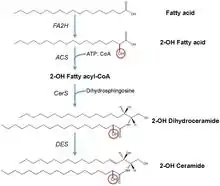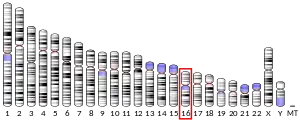Fatty acid 2-hydroxylase is a protein that in humans is encoded by the FA2H gene.[5]
Function
This gene encodes a protein that catalyzes the synthesis of 2-hydroxysphingolipids, a subset of sphingolipids that contain 2-hydroxy fatty acids. Sphingolipids play roles in many cellular processes and their structural diversity arises from modification of the hydrophobic ceramide moiety, such as by 2-hydroxylation of the N-acyl chain, and the existence of many different head groups.[5]

Clinical significance
Mutations in this gene have been associated with leukodystrophy dysmyelinating with hereditary spastic paraplegia type 35 (SPG35) with or without dystonia[5] as well as fatty acid hydroxylase-associated neurodegeneration.[6] The largest cohort with a detailed phenotypical description and a highly sensitive imaging phenotype ('WHAT'- acronym for: white matter changes, hypointensity of the globus pallidus, ponto-cerebellar atrophy, and thin corpus callosum) was recently published.[7]
FA2H has been shown to modulate cell differentiation in vitro. FA2H is may be a Δ9-THC-regulated gene, as Δ9-THC induces differentiation signal(s) in poorly differentiated MDA-MB-231 cells.[8]
References
- 1 2 3 GRCh38: Ensembl release 89: ENSG00000103089 - Ensembl, May 2017
- 1 2 3 GRCm38: Ensembl release 89: ENSMUSG00000033579 - Ensembl, May 2017
- ↑ "Human PubMed Reference:". National Center for Biotechnology Information, U.S. National Library of Medicine.
- ↑ "Mouse PubMed Reference:". National Center for Biotechnology Information, U.S. National Library of Medicine.
- 1 2 3 "Entrez Gene: Fatty acid 2-hydroxylase". Retrieved 2011-12-30.
- ↑ Pierson TM, Simeonov DR, Sincan M, Adams DA, Markello T, Golas G, et al. (April 2012). "Exome sequencing and SNP analysis detect novel compound heterozygosity in fatty acid hydroxylase-associated neurodegeneration". European Journal of Human Genetics. 20 (4): 476–9. doi:10.1038/ejhg.2011.222. PMC 3306865. PMID 22146942.
- ↑ Rattay TW, Lindig T, Baets J, Smets K, Deconinck T, Söhn AS, et al. (June 2019). "FAHN/SPG35: a narrow phenotypic spectrum across disease classifications". Brain. 142 (6): 1561–1572. doi:10.1093/brain/awz102. PMC 6536916. PMID 31135052.
- ↑ Takeda S, Harada M, Su S, Okajima S, Miyoshi H, Yoshida K, Nishimura H, Okamoto Y, Amamoto T, Watanabe K, Omiecinski CJ, Aramaki H (2013). "Induction of the fatty acid 2-hydroxylase (FA2H) gene by Δ(9)-tetrahydrocannabinol in human breast cancer cells". The Journal of Toxicological Sciences. 38 (2): 305–8. doi:10.2131/jts.38.305. PMC 4018719. PMID 23535410.
Further reading
- Alderson NL, Rembiesa BM, Walla MD, Bielawska A, Bielawski J, Hama H (November 2004). "The human FA2H gene encodes a fatty acid 2-hydroxylase". The Journal of Biological Chemistry. 279 (47): 48562–8. doi:10.1074/jbc.M406649200. PMID 15337768.
- Uchida Y, Hama H, Alderson NL, Douangpanya S, Wang Y, Crumrine DA, Elias PM, Holleran WM (May 2007). "Fatty acid 2-hydroxylase, encoded by FA2H, accounts for differentiation-associated increase in 2-OH ceramides during keratinocyte differentiation". The Journal of Biological Chemistry. 282 (18): 13211–9. doi:10.1074/jbc.M611562200. PMID 17355976.
- Dick KJ, Al-Mjeni R, Baskir W, Koul R, Simpson MA, Patton MA, Raeburn S, Crosby AH (July 2008). "A novel locus for an autosomal recessive hereditary spastic paraplegia (SPG35) maps to 16q21-q23". Neurology. 71 (4): 248–52. doi:10.1212/01.wnl.0000319610.29522.8a. PMID 18463364. S2CID 207102944.
- Edvardson S, Hama H, Shaag A, Gomori JM, Berger I, Soffer D, Korman SH, Taustein I, Saada A, Elpeleg O (November 2008). "Mutations in the fatty acid 2-hydroxylase gene are associated with leukodystrophy with spastic paraparesis and dystonia". American Journal of Human Genetics. 83 (5): 643–8. doi:10.1016/j.ajhg.2008.10.010. PMC 2668027. PMID 19068277.
- Wheeler HE, Metter EJ, Tanaka T, Absher D, Higgins J, Zahn JM, Wilhelmy J, Davis RW, Singleton A, Myers RM, Ferrucci L, Kim SK (October 2009). Gibson G (ed.). "Sequential use of transcriptional profiling, expression quantitative trait mapping, and gene association implicates MMP20 in human kidney aging". PLOS Genetics. 5 (10): e1000685. doi:10.1371/journal.pgen.1000685. PMC 2752811. PMID 19834535.
- Dastani Z, Pajukanta P, Marcil M, Rudzicz N, Ruel I, Bailey SD, Lee JC, Lemire M, Faith J, Platko J, Rioux J, Hudson TJ, Gaudet D, Engert JC, Genest J (March 2010). "Fine mapping and association studies of a high-density lipoprotein cholesterol linkage region on chromosome 16 in French-Canadian subjects". European Journal of Human Genetics. 18 (3): 342–7. doi:10.1038/ejhg.2009.157. PMC 2824775. PMID 19844255.
- Dick KJ, Eckhardt M, Paisán-Ruiz C, Alshehhi AA, Proukakis C, Sibtain NA, Maier H, Sharifi R, Patton MA, Bashir W, Koul R, Raeburn S, Gieselmann V, Houlden H, Crosby AH (April 2010). "Mutation of FA2H underlies a complicated form of hereditary spastic paraplegia (SPG35)". Human Mutation. 31 (4): E1251-60. doi:10.1002/humu.21205. PMID 20104589. S2CID 5344306.
- Dan P, Edvardson S, Bielawski J, Hama H, Saada A (May 2011). "2-Hydroxylated sphingomyelin profiles in cells from patients with mutated fatty acid 2-hydroxylase". Lipids in Health and Disease. 10: 84. doi:10.1186/1476-511X-10-84. PMC 3107802. PMID 21599921.



